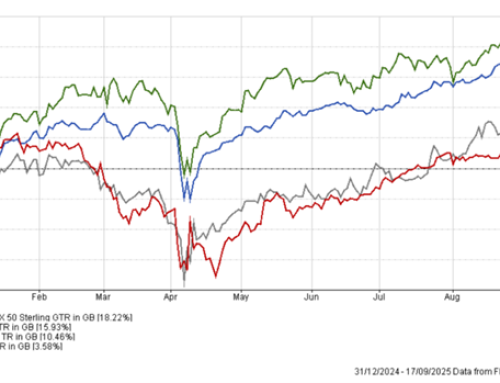Andrew’s Views
Things had been going very well during July, and I had written a very different market update, and then on the very last day of the month we saw some huge falls across the world. Whilst most of the volatility has calmed and the losses mostly clawed back, Japan saw the largest falls. A major driver of the weakness in Japanese stocks was the strength of the Japanese yen.
Most of the activity took place in the early hours of Monday morning when the Japanese TOPIX index fell a stunning 12% in a single session. This capped a three-day descent into the technical definition of a bear market (a 20% cumulative decline).
Before we get too carried away, the TOPIX had recovered by 11.5% when the Japanese market closed on Friday. So, the peak-to-trough decline of the Japanese market since mid-June was 24% but is now just 15%. In sterling terms, this would represent a 15% total decline and just 7.5% following the partial recovery. The decline in Japanese stocks is different depending upon whether you’re a Japanese investor (in yen) or a UK investor (in sterling).
The Bank of Japan (BoJ) has been keen to move very slowly in its interest rate normalisation process. Last week, the BoJ’s deputy governor, Shinichi Uchida, also sent a strong dovish signal in the wake of historic financial market volatility in Japan by pledging to refrain from hiking interest rates when the markets are unstable.
It seems likely that the BoJ is very focused on the impact of interest rates, mostly because its domestic demand and exports could be impacted by currency volatility caused by interest rate movements.
Japanese domestic investors have been buying overseas assets. By contrast, U.S. investors invest principally at home, allowing the Federal Reserve to be more parochial with its monetary policy. Any weakness in the U.S. economy will be met by interest rate cuts, inflicting more potential pain on international traders.
A lot of the falling markets was due to weak economic data coming from the US. In reality it wasn’t actually weak economic data, it just wasn’t data showing a strong economy, which is a long way from showing a weak economy. However, there hasn’t been much data published since then which provides further insights, allowing for this ‘weak economy’ viewpoint to persist longer than it really should.
There also wasn’t much data about the fundamentals that may drive U.S. rate cuts or Japanese rate hikes. As mentioned, the BoJ will tread carefully.
In the U.S., weekly jobless claims cut a reassuring tone, with new claims falling well below previous troughs during economic expansions. The caveat to this is that far fewer people now claim the unemployment insurance benefit in the U.S. than previously. Why? The explanation seems to be that either they are migrants who may not yet qualify for insurance, or they find opportunities in the gig economy that are preferable to the hassle of claiming insurance.
We also remain in a liquidity trough due to the summer holiday season, and the earnings season is unlikely to change the market’s perception of consumer strength (although it will be interesting to hear from the discount retailers still to report).
Friday morning saw the Taiwan Semiconductor Manufacturing Company report a sharp increase in revenue in July, which bodes well for suppliers like ASML following the bruising market response to Intel’s planned reduction in capital expenditure the week before last. Technology shares have suffered during the current earnings season due to fears they might be overinvesting.
This week, we’ll see what’s happening to inflation in the U.S. It’s easy to imagine the market has moved on from inflation. After two months of reassuringly low inflation, focus has shifted to growth. Continued weakness of inflation will be good for bonds, but bad news for currency traders, who are invested in the dollar market.
There’ll also be UK inflation and employment data. The Bank of England has taken the plunge and started cutting interest rates. It could probably do with seeing its decision validated by some modest weakness.


